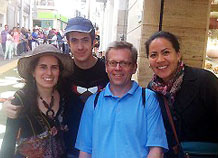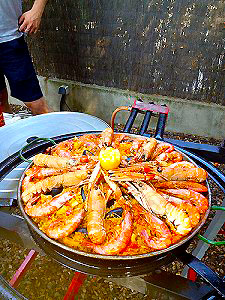The International Language of Science

This article originally appeared on UConn Today and is being republished courtesy of the author, Mark Peczuh, Department of Chemistry, University of Connecticut.
 I can’t say it plainly enough. My experience as a Fulbright Scholar in Barcelona this past year transformed me, both professionally and personally. I returned to Connecticut not only with a broader perspective on my research but with a profound sense of place and the amazing impact of personal relationships.
I can’t say it plainly enough. My experience as a Fulbright Scholar in Barcelona this past year transformed me, both professionally and personally. I returned to Connecticut not only with a broader perspective on my research but with a profound sense of place and the amazing impact of personal relationships.
Perhaps most importantly, I returned with a sense of what I had always known but had never experienced quite like this: science is an international language, spoken around the world by people with a thirst for new knowledge.
When I first arrived in Barcelona, my life was a maelstrom of impressions and emotions: new sights, new smells, late lunch and later dinner, hearing and speaking the Catalan language, the kindness of the locals, and somehow within it all, a sense of solitude. I had chosen to work at the Chemistry Institute of Sarria (IQS) with Professor Antoni Planas, known to everyone as Toni. My host and his laboratory were the one constant during my transition.
Within a couple of weeks, I had learned the basics of day-to-day living, and I began to feel like l was a local. Science is inherently international, so the lab was a logical place to connect with something that was familiar to me.
Toni is world-famous for developing glycosynthases, which are engineered proteins that have their origins in sugar metabolism. The term glycosynthase was coined to indicate that the enzymes could use sugars (“glyco”) to synthesize (“synthase”) new polymers.
Glycosynthases caught my eye because my research group at UConn synthesizes artificial sugars and characterizes how proteins bind to them. Our expanded sugars compete with natural sugars for protein binding sites and could have implications for preventing bacterial infections, among other applications. We wanted to know whether glycosynthases could utilize our expanded sugars in their reactions.

With help from Hugo Aragunde-Pazos, a graduate student at IQS, I prepared the enzymes and looked at their activity using compounds from my lab. Aside from doing the science itself, working in the laboratory with Spanish students was a curriculum in language, both Spanish and Catalan. Although I’ve been exposed to the Spanish language – my wife is Colombian and Spanish – I spent significant energy on simple communication. My labmates were remarkably helpful and patient with my slow language skills.
Eventually, the language barrier broke down, and I was able to easily communicate, but the experience made a strong impression on me. Now I better empathize with the challenges that face international researchers in the U.S.
The results of the research showed that our sugars are weak substrates for glycosynthases; this is actually encouraging because our sugars shouldn’t be degraded by natural enzymes if they are used as drugs. It also allows us to develop new enzymes, via mutation and screening, that will only accept our sugars.
The heart of the science

In the spirit of the Fulbright program, which encourages open exchanges of ideas with people from different parts of the world, I interviewed a few scientists in Barcelona whose research interests are similar to mine. I spoke with my friend, Xavi Salvatella; Ernest Giralt, who was a collaborator with my Ph.D. advisor; and Lluis Ribas, a scientist and entrepreneur working on the development of new antibiotics. All are researchers at Barcelona’s Institute for Research in Biomedicine.
In the interviews, I asked about their research programs, how they ended up at the IRB, and what it meant for them to be doing research in Barcelona. Each of them expressed a strong connection to Catalunya – their region of Spain, and to their families and friends who live there.
It struck me that these things – identification with “home” and close personal relationships – make any group unique, but it is also common to all groups. I realized that these scientists have made choices that balance their scientific passion with their cultural identification and feelings about what is “home.” The realization has kindled a desire in me to remember the importance of people and place in my daily life.
You simply can’t go to Catalunya without taking a few excursions to take in cultural sights. A highlight was a day trip to the nearby beach town of Sitges on Corpus Christi, a holiday, to see the “carpets of flowers,” kind of like a stationary Rose Parade.

A series of 10-foot-tall puppets, known as “gigantes,” danced through the streets while simultaneously destroying the carpets. My companions couldn’t explain why the gigantes had to destroy the flower creations, but it seemed symbolic to me.
It’s also difficult to talk about Spain without mentioning food. Paella was both the food and the entertainment at a party in honor of Toni, who had just received the Fischer Prize at the 2013 European Carbohydrate Symposium. After we had consumed mountains of paella, there was a viewing of a video, “Planas Style,” a Catalan rendition of Psy’s “Gangnam Style.” It was filmed in honor of Toni, but also to parody him. I suppose this is evidence that some cultural phenomena, especially pop culture, are truly international.
Now I’ve returned to the Connecticut I know and love, but I often find myself reminiscing about the cultural immersion I experienced in a land so different from mine. Beyond the scientific collaboration that I sought on my trip, I now have a deeper understanding of how Catalans see the world and themselves. I am attached to both the specifics of this perspective – in terms of Catalunya’s uniqueness within Spain – and also the broader sense of place and relationships.
As I watch the autumn leaves change and fall to the ground and notice the red barns rising over Horsebarn Hill, I can only hope that I revealed a Nutmegger’s perspective of the world to my new friends in Barcelona in the same way that they shared their culture with me.
